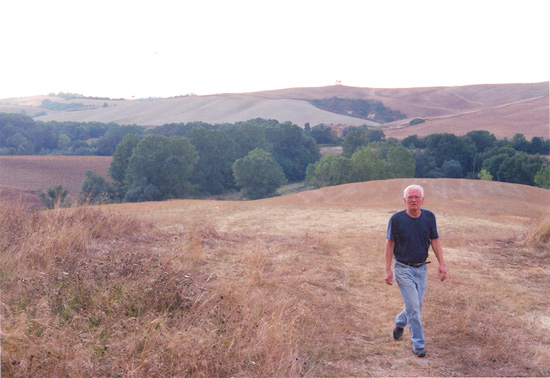George Schneeman’s
Italian Hours
by Bill Berkson

Distinct in
atmosphere, thin clouds blown by the wind, forms bathed in and defined
by light.
— John-Pope Hennessey on Sassetta’s predella for Madonna
of the Snows
Over the past
forty years or more, George Schneeman’s art has comprised portraits
of his family and friends on canvas and in portable frescoes on cinder
blocks, collages and paintings based on collages, painted ceramics,
and countless cover designs and drawings for books of poetry and little
magazines. (He has also devoted considerable studio time to hands-on
collaborations with poets in various media.) Bracketing these segments
of work, and sometimes intercutting among them, have been the Italian
landscapes begun during the time Schneeman first lived in Tuscany from
1958 to 1966 and resumed in the 1990s after he started revisiting the
Tuscan countryside, having spent the intervening decades solidly in
New York. (He and his wife Katie now divide their year between apartments
on St. Marks Place and in the commune of San Giovanni d’Asso, southeast
of Siena.)
The recent landscapes are tempera on carefully gessoed plywood panels.
Practicalities -- storage and portability, especially -- argue for settling
upon a reduced size, without stinting on a picture’s energy requirements.
Averaging twelve by nine inches, done on location in half-hour sittings,
the panels exemplify, Schneeman says, “the struggle between miniature
and landscape” -- which links the question of the size at which
a landscape painting can register across a room to the thornier one
of how in a compact two-dimensional space depth and surface will compare
notes so that all that is visible can be both actual and clear.
An allegorist by disposition, Schneeman brings out the characteristic
drama of each scene, keeping it from being merely a view or bella vista,
and projecting more of what he calls “spatial sentiment.”
By Tuscan standards, these views are as ordinary as their place names
-- Il Moro, Castelletto, Poggio di Val di Rigo, and so on -- are plainly
functional. Formed in a fissured slope or where a couple of rumpled,
vivid gray and brown rises meet, a crotch of ground fills up lustily
with thatched greens. There are subtler moments, as well, mostly little
details daubed along the ridges: a dark vertical sliver says “distant
cypress;” a cuticle of brick red makes an isolated farmhouse roof.
Further off, exquisite incidentals of buildings cluster together amid
trees, making some sought-after shade. Still higher, the necessity arises
“to invent something in the sky that relates it to the land.”
Is spatial sentiment a more far-reaching, iconic version of Cézanne’s
“little sensation,” more keyed to the bigger sweep of what
the persistent observer takes in? The answer may be found in the painter’s
process as Schneeman tells of it:
I don’t forget the brushes or the water or the palette or the
board to paint. And I have to take advantage of the clear days, because
sometimes a haziness will set in for a week or more. We’ve already
had one spell of that: and it’s hard to paint clearly when the
landscape is clogged. But even now I haven’t had those beautiful
clouds to work on. Clouds always make it clearer that there’s a
heaven and earth. And space between them.
A slightly different version of this essay appeared in the catalogue
accompanying George Schneeman’s exhibition of landscape paintings,
curated by Bill Berkson, at CUE Arts Foundation in New York, October
16-November 22, 2003.
|

